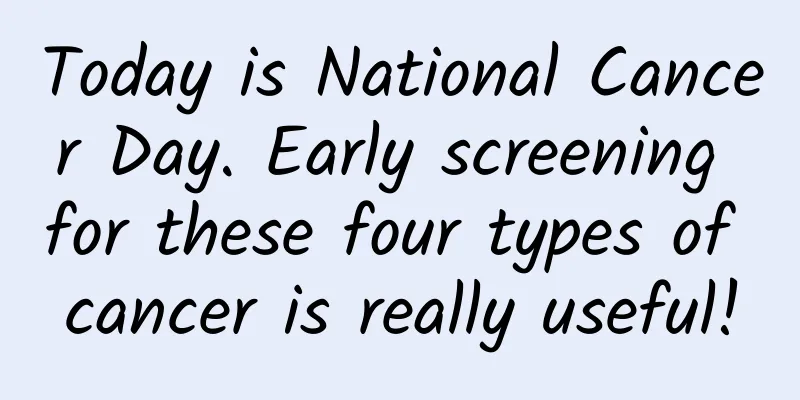Today is National Cancer Day. Early screening for these four types of cancer is really useful!

|
Today is April 15th, also National Cancer Day. Nowadays, many people attach great importance to physical examinations. When doing physical examinations, doctors will recommend some cancer screening. What are these dazzling cancer screening items, and can they really screen out cancer? Copyright images in the gallery. Reprinting and using them may lead to copyright disputes. Cancer screening is a cancer prevention measure for asymptomatic "healthy people", that is, taking the initiative to do relevant examinations when there is no abnormal discomfort in the body, with the purpose of discovering early cancer and precancerous lesions, and achieving early detection, early diagnosis and early treatment. Cancer screening measures usually require relatively clear effectiveness and specificity (relatively sensitive detection of early cancer and precancerous lesions), safety (no obvious side effects), simplicity, economy and good operability . However, we cannot only see the positive side of screening, but also pay attention to some potential negative effects of screening , such as CT radiation hazards, false positive screening results, overdiagnosis, overtreatment, etc. Therefore, screening cannot be done blindly. Necessary assessments must be conducted before screening, and screening must be arranged in a targeted manner based on specific circumstances to minimize the possible negative effects of screening. Currently, the cancers that have sufficient research evidence, a relatively high degree of consensus, and are most recommended for screening are mainly lung cancer, breast cancer, cervical cancer, and colorectal cancer. Therefore, today, referring to the relevant screening guidelines of the National Health Commission/National Cancer Center, China Anti-Cancer Association/Chinese Medical Association and its affiliated branches, we will provide popular science on the 4 most common cancer screenings with a high degree of consensus for your reference. Lung cancer screening Lung cancer is the malignant tumor with the highest morbidity and mortality rate. Evidence from domestic and foreign research shows that screening for high-risk groups can detect lung cancer early, achieve early diagnosis and treatment, improve prognosis, and reduce mortality. Copyright images in the gallery. Reprinting and using them may lead to copyright disputes. 1 Which groups of people should be screened? Lung cancer screening is mainly for high-risk groups. Screening is not routinely recommended for non-high-risk groups (it can be determined individually based on specific circumstances). Who is at high risk for lung cancer? People with any of the following conditions are at high risk for lung cancer: ① Long-term smoking (smoking pack-years ≥ 30 pack-years, including former smokers with a pack-year of ≥ 30 pack-years but quitting less than 15 years ago). Note: Smoking pack-years = number of packs smoked per day (20 cigarettes per pack) × number of years of smoking. ② Long-term passive smoking (living or working in the same room with smokers for a long time) ≥ 20 years. ③ Occupational contact/exposure history ≥ 1 year (including occupational exposure to asbestos, beryllium, uranium, radon, chromium, cadmium, nickel, silicon, coal smoke and coal dust, etc.). ④ Family history of lung cancer (first-degree relatives such as parents, children, and siblings with the same parents have been diagnosed with lung cancer). ⑤ History of chronic lung disease such as chronic obstructive pulmonary disease (COPD) or diffuse pulmonary fibrosis. Different guidelines have different starting ages for screening, with some suggesting starting at 45 and others at 55. It is usually recommended to start screening at least at 50 (screening can be started earlier at 45 or 40, depending on individual preferences). Screening can be stopped after the age of 74, but it is not absolute. Screening can still be continued according to the situation and personal preferences. 2 How is screening performed? It is recommended that high-risk groups undergo low-dose spiral CT (LDCT) chest screening once a year. Chest X-ray screening is not recommended. Breast cancer screening Breast cancer is the most common malignant tumor in women, and its morbidity and mortality rates are both on the rise. Although the 5-year survival rate of breast cancer patients in my country has improved in recent years, it is still one of the main causes of cancer death in women. Copyright images in the gallery. Reprinting and using them may lead to copyright disputes. 1 Which groups of people should be screened? Both the general risk group and the high risk group are suitable for breast cancer screening. The general risk group refers to those with an average or low risk of cancer, that is, all women of appropriate age except those at high risk. The definitions (standards) of high-risk groups in different screening guidelines are not completely consistent. People with any of the following conditions are usually considered to be at high risk for breast cancer: ① Those with a family history of genetic disease (i.e., those with a clear genetic tendency to breast cancer, including: first-degree relatives with a history of breast cancer or ovarian cancer; 2 or more second-degree relatives with ovarian cancer and/or breast cancer before the age of 50; or those who carry or have at least 1 first-degree relative with a known BRCA1/2 gene pathogenic genetic mutation). Note: First-degree relatives refer to mothers, daughters, and sisters; second-degree relatives refer to aunts, aunts, grandmothers, and grandmothers. ② Previously (before the age of 30) received chest radiotherapy. ③ Patients with a history of atypical breast ductal or lobular hyperplasia or lobular carcinoma in situ. ④ Other high-risk individuals: Risk assessment is performed through multiple risk factors to determine whether they are high-risk individuals, such as early menarche (≤12 years old); late menopause (≥55 years old); history of breast biopsy or surgery for benign breast diseases; use of hormone replacement therapy with "combined estrogen and progesterone" or only "estrogen" (for no less than half a year); never breast-feeding or breast-feeding for less than 4 months; first childbirth age ≥30 years old or never giving birth, history of miscarriage or stillbirth, or 2 or more miscarriages, etc. Regarding the starting age for screening, based on national conditions, it is usually recommended that people at general risk start screening at age 40, and high-risk groups are recommended to start screening for breast cancer at an earlier age (<40 years old). 2 How is screening performed? For the general risk population: screening is recommended every 1 to 2 years, either mammography (molybdenum target) or breast ultrasound alone; for dense breasts, mammography combined with breast ultrasound is recommended. Breast MRI is not recommended as a routine screening measure for the general risk population. High-risk groups: It is recommended to have a mammogram once a year, a breast ultrasound every 6 to 12 months, and a breast physical examination every 6 to 12 months (physician's inspection and palpation, etc.); combined with breast enhanced MRI when necessary (especially for BRCA1/2 gene mutation carriers, but usually not the preferred method). Cervical cancer screening Cervical cancer is a common malignant tumor that threatens women's health. Most cases are caused by human papillomavirus (HPV) infection. Therefore, HPV vaccination is the most effective measure to prevent cervical cancer, but it cannot replace cervical cancer screening. Screening is still an important measure to prevent cervical cancer. Copyright images in the gallery. Reprinting and using them may lead to copyright disputes. 1 Which groups of people should be screened? Taking into account the national conditions, it is generally recommended that women start cervical cancer screening at the age of 25. Women under 25 years old: If they have a history of multiple sexual partners, a history of early sexual activity, HIV infection, smoking and other high-risk factors, it is recommended to undergo screening in advance (starting within 1 year after the start of sexual activity) and shorten the screening interval appropriately. It should be noted that regardless of whether or not you have received the HPV vaccine, regular cervical cancer screening should be required. 2 How is screening performed? The main screening methods are cervical cytology (TCT, thin layer liquid-based cytology technology) and human papillomavirus (HPV) nucleic acid testing. Women aged 25-64: HPV nucleic acid test alone, or HPV test combined with cytology test every 5 years; or cervical cytology test every 3 years. Women over 65 years old do not need to undergo screening if they have sufficient negative screening records (three consecutive cytology screenings or two consecutive HPV screenings or combined screenings within 10 years, and the most recent screening was within 5 years, and the screening results were normal), and do not have high-risk factors such as CIN (cervical intraepithelial neoplasia), persistent HPV infection, and no history of treatment for HPV-related diseases. However, if women over 65 years old have never been screened before, or do not have sufficient negative screening records in the 10 years before the age of 65, or have clinical indications, they should still be screened. Colorectal cancer screening Colorectal cancer (colon cancer) is a common malignant tumor of the digestive tract and one of the main causes of cancer death, with both the incidence and mortality rates showing an upward trend. Copyright images in the gallery. Reprinting and using them may lead to copyright disputes. 1 Which groups of people should be screened? It is recommended that people at general risk undergo colorectal cancer risk assessment starting at the age of 40: if assessed as a medium-risk group, it is recommended to undergo colorectal cancer screening at the age of 50 to 75; if the assessment result is a high-risk group, it is recommended to undergo colorectal cancer screening at the age of 40 to 75. If one or more first-degree relatives have colorectal cancer, screening is recommended to begin at age 40, or 10 years earlier than the youngest first-degree relative. If you are a high-risk group for hereditary colorectal cancer, the starting age for screening will be further advanced, and the frequency of screening will also be increased. For example, the starting age for colonoscopy screening for high-risk people with Lynch syndrome caused by MLH1/MSH2 mutations is 20 to 25 years old, or 2 to 5 years earlier than the onset age of the youngest patient in the family; the starting age for colonoscopy screening for high-risk people with Lynch syndrome caused by MSH6/PMS2 mutations is 30 to 35 years old, or 2 to 5 years earlier than the onset age of the youngest patient in the family; high-risk people in typical FAP families start receiving colonoscopy screening at the age of 10 to 11, and have a colonoscopy every 1 to 2 years, and continue for life; high-risk people in mild FAP families should start at the age of 18 to 20, have a colonoscopy every 2 years, and continue for life. Those who do not have the following risk factors can be considered as the general risk group: first-degree relatives with a history of colorectal cancer, the person has a history of colorectal cancer or intestinal adenoma, the person has long-term inflammatory bowel disease for 8 to 10 years, and the person has a positive fecal occult blood test. High-risk groups include sporadic high-risk groups and hereditary high-risk groups. Hereditary high-risk groups for colorectal cancer mainly include non-polyposis colorectal cancer (Lynch syndrome and familial colorectal cancer type x Lynch-like syndrome) and polyposis colorectal cancer syndrome (familial adenomatous polyposis, MUTYH gene-related polyposis, juvenile polyposis syndrome, serrated polyposis syndrome, etc.). 2 How is screening performed? The screening methods mainly include colonoscopy (screening gold standard), FIT (fecal immunochemical test), sigmoidoscopy (mainly suitable for distal colorectal cancer screening), colon CT imaging technology (can be used for screening under specific conditions), and multi-target fecal FIT-DNA testing (can be used for screening under specific conditions). It is generally recommended to have a high-quality colonoscopy every 5 to 10 years (strong recommendation); or a FIT examination once a year (strong recommendation); or a sigmoidoscopy every 3 to 5 years (weak recommendation); or a colon CT imaging examination every 5 years (weak recommendation); or a multi-target fecal FIT-DNA test every 3 years (weak recommendation). Finally, special attention should be paid to the follow-up treatment of the screening: if the screening result is negative, continue screening at the above-mentioned time intervals; if the screening finds abnormal results, seek help from a doctor of the corresponding specialist for further examination and treatment and/or adjustment of the reexamination and follow-up strategy based on the specific situation. Planning and production Author: Pan Zhanhe, Chief Physician, Master's Supervisor, Department of Oncology, Zhongshan Hospital, Xiamen University Reviewer: Tang Qin, Director and Researcher of the Science Popularization Department of the Chinese Medical Association Planning丨Yinuo Editor: Yinuo Proofread by Xu Lai and Lin Lin The cover image and some images in this article are from the copyright gallery. The image content is not authorized for reprinting. |
<<: Make the map visual! She uses geographic information system to reflect the real world
>>: 350 kilometers per hour! This high-speed railway will cross the Qinling Mountains
Recommend
Interpreting ASP.NET 5 & MVC6 Series (4): Core Technology and Environment Configuration
asp.net 5 is the next generation of asp.net. This...
Spending billions of dollars but still having no users, what is the key to user growth?
Recently, many people around me have come to me t...
Lei Jun and Zhou Hongyi battle against each other: Can Xiaomi defeat 360 again?
[[133571]] Three years ago, Qihoo 360 launched a ...
A complete collection of online marketing videos for 19.9 yuan: including SEO, SEM, website building, website imitation, and online marketing promotion worth 20,000 yuan!
Learning materials worth 20,000 only cost 19.9 yu...
Who is healthier, someone who sweats when it gets hot or someone who doesn’t sweat even if it’s too hot?
【Written at the end】 If you suffer from heart dis...
Wang Qiong's tea art video tutorial "11 Tea Cultivation Courses on Body and Qiyun" teaches you to be a smart goddess
Wang Qiong's tea art video tutorial "11 ...
The key to growth: How to improve user retention?
Retention , as the name suggests, means that user...
Zhong Nanshan: Omicron infection is not scary, 99% can fully recover within 7 to 10 days!
At the "Chinese Medical Association Respirat...
Teacher Yu Ying's postpartum repair and shaping of the pelvic girdle repair & the required course for the transformation of hot moms 108 minutes
Teacher Yu Ying's postpartum repair and shapi...
There are thousands of causes of fever, but very limited antimicrobial drugs
Patient: "Pharmacist, my child has a fever o...
6 warning signs before a heart attack! Remember these, they can save lives at critical moments!
November 20th is "China's Myocardial Inf...
After driving away the police, Starbucks announced a price increase. How long can it continue to be arrogant in the country?
Starbucks’ “high-end” label in the country is bei...
Advantages and display forms of Kuaishou advertising!
Nowadays, the short video industry is developing ...
The 10 most popular growth hacking strategies in China in 2017
Any growth practice starts with small things. In ...
From the “big characters” that flood the friend circle, let’s look at the 7 logics behind the article being forwarded!
Last Friday, everyone suddenly discovered that a ...









